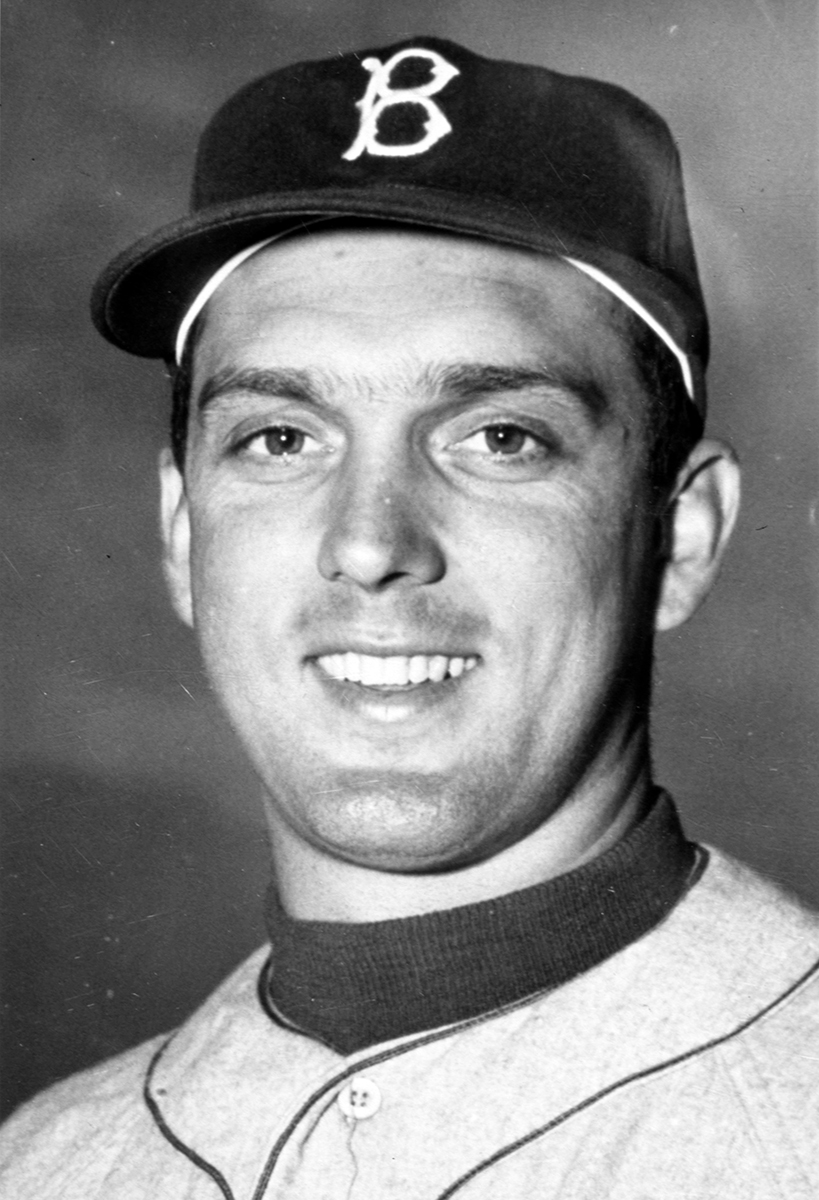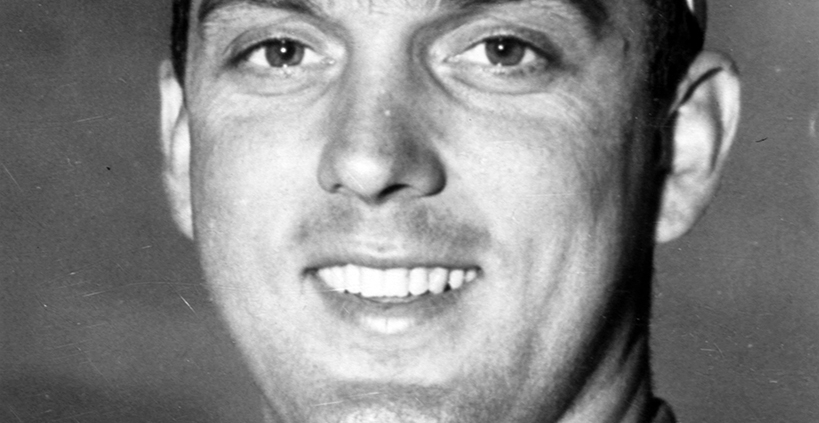May 12, 1956: Carl Erskine’s second no-hitter is first to be broadcast on national TV

“Not bad for a junk pitcher, and for nine old men,” shouted Jackie Robinson after Carl Erskine’s no-hitter.1 Robinson’s ire was directed toward New York Giants scout Tom Sheehan, whose club had just been beaten by the team he considered to be over the hill. Erskine became only the 10th pitcher since 1900 to toss two no-hitters, and his performance was the first nationally televised no-hitter. It aired on CBS’s Game of the Week, and suggested that the reigning World Series champions weren’t ready to roll over just yet.2
Jackie’s contempt aside, Sheehan’s comments seemed to reflect on Erskine, whom Dodgers skipper Smoky Alton had described as a “question-mark pitcher” in spring training.3 At just 29 years old, Erskine’s glory days seemed to be over, though his list of accomplishments was long. He had tossed a no-hitter against the Chicago Cubs in 1952, won 20 games in 1953, set a World Series record (later broken) by fanning 14 batters in Game Three of the ‘53 fall classic,4 and earned an All-Star Game berth in 1954. While Dem Bums marched to the pennant in 1955, Erskine struggled over the last two months of the season, plagued by potentially career-ending bone spurs in his elbow. He was shelled for 27 earned runs in his last 44 innings (5.52 ERA) beginning on August 9 and failed to go beyond five innings in five of his eight starts. His struggles continued in the Dodgers’ World Series victory over the Yankees. He was knocked out of Game Three after yielding three earned runs in three innings.
The Dodgers might have played like old men in the first few weeks of the 1956 season, at least compared with a year earlier. Preparing for the second game of a three-game set with the Giants, Alston’s squad was 10-9, three games behind the St. Louis Cardinals, in fourth place. In 1955 they had won their first 10 games and 22 of 24 in one of the best starts in big-league history. But in ‘56 the offense seemed flat and the pitching staff had already been victimized for at least 10 runs in a game on four occasions. The Dodgers had an encouraging sign in their previous game, scoring a season-high eight runs in their win against the Giants. Just 18 months removed from winning the World Series, manager Bill Rigney’s club was likewise faltering and in sixth place (9-11).
As the 1956 season commenced, little was expected of Erskine, whom sportswriter Dana Mozley described as “the little gentleman whose heart is often stronger than his arm.”5 The slightly built, 5-foot 10, 165-pound right-hander, who began the season with a 100-57 lifetime record, went nine innings in his first two starts, one of which was a victory against the Giants at the Polo Grounds; however, he felt weak in his last two starts, both losses on the road. Never a hard thrower, he thought his fastball had lost its zip. Taking the advice of two friends, he exercised and warmed up before his start against his crosstown rivals with a stainless steel ball in order to loosen his muscles and stretch his wrist.6
On a sunny spring Saturday afternoon with temperatures in the mid-60s and rising at the 2:00 start time, Ebbets Feld was packed with 24,588 fans on Ladies Day (paid attendance was 17,395).7
The game pitting rivals unfolded as a tense pitchers’ duel. Erskine breezed through the first two innings, yielding only one baserunner, a walk to Willie Mays in the opening frame. In the second, Bill White tagged Erskine for a deep shot that flew over the right-field fence and onto Bedford Avenue, but it was foul by seven or eight feet, according to the Daily News.8
On the mound for the Giants was three-year veteran right-hander Al Worthington, back in the majors after spending the entire 1955 season in the minors to work on his control. Through the first six innings, he yielded just two hits, but was undone by his wildness, issuing six walks, including three in the third. In that frame, Pee Wee Reese drew a one-out free pass. Duke Snider raked a single to center field which Mays “fumbled.”9 Reese didn’t want to test Mays’s arm and held up at second. After Roy Campanella’s dribbler in front of home plate advanced both runners, Gil Hodges walked to load the bases, and Robinson’s walk plated Reese with the first run. Sandy Amoros fanned to end the threat.
Staked to a one-run lead. Erskine walked Alvin Dark to lead off the fourth inning, which proved to be his toughest. Mays, who entered the game in a season-long funk batting just .225 (12-for-80), smashed a wicked liner to third base. Jackie Robinson instinctively dived to his left and caught the ball, though he “fell hard, perhaps carried by the momentum of the drive as much as by the effort of his lunge,” reported the Daily News.10 After slumping Dusty Rhodes, homerless in 44 plate appearances thus far in ‘56 and batting .237, popped up behind the plate to Campanella, Daryl Spencer sent a drive to the deepest part of the ballpark, in right-center field. It looked “good for extra bases,” opined sportswriter John Drebinger of the New York Times.11 Carl Furillo, back after missing the last two games because of a cold, took off and had it played perfectly. The Reading Rifle made a nifty over-the-head, off-balance grab.
Willie Mays’s defense saved a run in the sixth. After Furillo drew a two-out walk, Erskine doubled to the left-center-field wall. Rhodes fielded the ball, then flipped it to Mays. According to the Daily News, Mays’s 340-foot throw was a bit offline to catcher Ray Katt, who was still able to pick up the ball, dive, and tag a sliding Furillo in what was surely the highlight sequence of the game.12
The Dodgers finally solved Worthington in the seventh. Reese laced a one-out single and scored on Snider’s double. Campanella’s single plated Snider and sent Worthington to the showers. Reliever Marv Grissom set down all five Dodgers he faced.
Erskine retired 18 consecutive batters after walking Dark to lead off the fourth. “I definitely didn’t have overpowering stuff,” he commented.13 He relied on his changeup and breaking balls, as well as an occasional fastball to keep the Giants guessing. He was “more confusing than overpowering,” opined Mozley.14 “[Erskine’s] speed was gone,” read a United Press report, “but his guile and courage carried him through.”15 The Giants pounded Erskine’s curves into the dirt for easy rollers and slow bounders, and hit only seven balls to the outfield. He fanned three, all on slow curves for called strikes.16 “[M]y curveball was my best pitch today,” he said “It was fooling them.”17
Erskine had some good fortune, too. Left-hander Don Mueller, pinch-hitting for Foster Castleman, hit a screeching liner with one out in the eighth. But it was right at Pee Wee Reese at shortstop who barely moved to make the catch.
As Erskine took the mound three outs from a no-hitter, Don Ferrarese of the Baltimore Orioles was trying to do the same at Yankee Stadium. Ferrarese yielded a leadoff single to Andy Carey in the ninth, settling for two-hit shutout. Erskine dispatched pinch-hitter George Wilson on a routine popup to first base. The next batter, Whitey Lockman sent Erskine’s first pitch into the right-field stands, but it hooked several feet foul. Lockman sent an 0-and-2 pitch back to Erskine on a tricky hop. “I reached down and swatted at the ball,” said Erskine. “I jammed the ball under the glove into the ground.”18 He recovered quickly and threw to Hodges for the second out. Hitting a team-high .329 entering the game, Dark stepped to the plate. “I was more worried about Dark than anyone else,” confessed Erskine about the contact hitter, one of the most difficult batters to strike out. “He slaps the ball and is tough to pitch to.”19 With his 102nd pitch, Erskine induced Dark to hit an easy tapper back to the mound. His throw to Hodges completed his no-hitter in 2 hours and 10 minutes.
Evening his record, 2-2, Erskine’s no-hitter was the highlight of his last productive, yet wildly inconsistent season in the majors (13-11; 4.25 ERA in 186⅓ innings). Bombed for six hits and five earned runs in a no-decision in his next start, on May 18 against the Cincinnati Reds, Erskine eventually dropped to 2-6. He then reeled off a career-best nine consecutive winning decisions, despite a 4.14 ERA, profiting from the Dodgers’ big bats. He ended the season on a 2-5 skid with a 5.34 ERA, as the Dodges secured their last pennant in Brooklyn on the final day of the season. Erskine spent his final three years as swingman and mop-up artist, retiring after the 1959 campaign with a 122-78 record.
SOURCES
In addition to the sources cited in the Notes, the author accessed Retrosheet.org, Baseball-Reference.com, SABR.org, and The Sporting News archive via Paper of Record.
Photo credit: Carl Erskine, SABR-Rucker Archive.
NOTES
1 Dick Young, “Exercise With Steel Ball Relaxes Carl’s Muscles,” New York Daily News, May 13, 1956: 98.
2 “Erskine Received a $500 Check from O’Malley for Pitching Feat,” New York Times, May 13, 1956: 185.
3 “Erskine Received a $500 Check from O’Malley for Pitching Feat.”
4 The record was broken by Sandy Koufax (17 K’s) in the 1963 World Series and Bob Gibson (17) in 1968.
5 Dana Mozley, “Erskine Wins His 2d No-Hitter, 3-0,” New York Daily News, May 13, 1956: 94.
6 Young.
7 Ladies Day attendance from Mozley. Weather from “Daily Almanac,” New York Daily News, May 13, 1956: 2.
8 Mozley.
9 Mozley.
10 Mozley.
11 John Drebinger, “Two Reach Base,” New York Times, May 13, 1956: 183.
12 Mozley.
13 “Erskine Received a $500 Check from O’Malley for Pitching Feat.”
14 Mozley.
15 United Press, “Carl’s 2d No-Hitter 1st on TV,” Binghamton (New York) Press and Sun-Bulletin, May 13, 1956: 1-D.
16 Mozley.
17 Young.
18 Mozley.
19 Young. Al Dark fanned just 534 times in 7,833 plate appearances. The ratio was even better during Dark’s most productive stretch (1951-1955), when he struck out 184 times in 3,244 plate appearances.
Additional Stats
Brooklyn Dodgers 3
New York Giants 0
Ebbets Field
Brooklyn, NY
Box Score + PBP:
Corrections? Additions?
If you can help us improve this game story, contact us.


